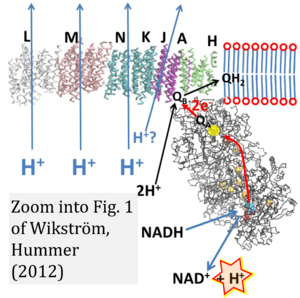Wikstroem 2012 Proc Natl Acad Sci U S A
| Wikström M, Hummer G (2012) Stoichiometry of proton translocation by respiratory complex I and its mechanistic implications. Proc Natl Acad Sci U S A 109:4431-6. |
Wikstroem M, Hummer G (2012) Proc Natl Acad Sci U S A
Abstract: Complex I (NADH-ubiquinone oxidoreductase) in the respiratory chain of mitochondria and several bacteria functions as a redox-driven proton pump that contributes to the generation of the protonmotive force across the inner mitochondrial or bacterial membrane and thus to the aerobic synthesis of ATP. The stoichiometry of proton translocation is thought to be 4 H(+) per NADH oxidized (2 e(-)). Here we show that a H(+)/2 e(-) ratio of 3 appears more likely on the basis of the recently determined H(+)/ATP ratio of the mitochondrial F(1)F(o)-ATP synthase of animal mitochondria and of a set of carefully determined ATP/2 e(-) ratios for different segments of the mitochondrial respiratory chain. This lower H(+)/2 e(-) ratio of 3 is independently supported by thermodynamic analyses of experiments with both mitochondria and submitochondrial particles. A reduced H(+)/2 e(-) stoichiometry of 3 has important mechanistic implications for this proton pump. In a rough mechanistic model, we suggest a concerted proton translocation mechanism in the three homologous and tightly packed antiporter-like subunits L, M, and N of the proton-translocating membrane domain of complex I.
• Bioblast editor: Gnaiger E
Hydrogen ion ambiguities in the electron transfer system
Communicated by Gnaiger E (2023-10-08) last update 2023-11-10
- Electron (e-) transfer linked to hydrogen ion (hydron; H+) transfer is a fundamental concept in the field of bioenergetics, critical for understanding redox-coupled energy transformations.
- However, the current literature contains inconsistencies regarding H+ formation on the negative side of bioenergetic membranes, such as the matrix side of the mitochondrial inner membrane, when NADH is oxidized during oxidative phosphorylation (OXPHOS). Ambiguities arise when examining the oxidation of NADH by respiratory Complex I or succinate by Complex II.
- Oxidation of NADH or succinate involves a two-electron transfer of 2{H++e-} to FMN or FAD, respectively. Figures indicating a single electron e- transferred from NADH or succinate lack accuracy.
- The oxidized NAD+ is distinguished from NAD indicating nicotinamide adenine dinucleotide independent of oxidation state.
- NADH + H+ → NAD+ +2{H++e-} is the oxidation half-reaction in this H+-linked electron transfer represented as 2{H++e-} (Gnaiger 2023). Putative H+ formation shown as NADH → NAD+ + H+ conflicts with chemiosmotic coupling stoichiometries between H+ translocation across the coupling membrane and electron transfer to oxygen. Ensuring clarity in this complex field is imperative to tackle the apparent ambiguity crisis and prevent confusion, particularly in light of the increasing number of interdisciplinary publications on bioenergetics concerning diagnostic and clinical applications of OXPHOS analysis.
Cited by
- Gnaiger E et al ― MitoEAGLE Task Group (2020) Mitochondrial physiology. Bioenerg Commun 2020.1. doi:10.26124/bec:2020-0001.v1.
Labels:
Enzyme: Complex I Regulation: Coupling efficiency;uncoupling
BEC 2020.1




